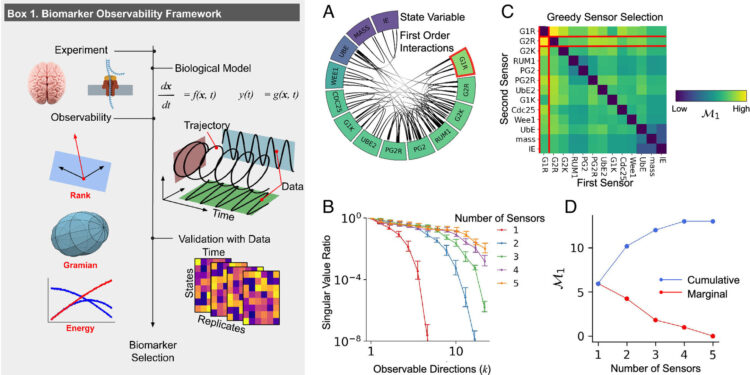Framework for applying observability to biological data. (Box 1) Models of biological systems are built from experimental data, and sensor selection determines which low-dimensional representations of the system’s trajectories will capture the most informative aspects of the system. Credit: Proceedings of the National Academy of Sciences (2025). DOI: 10.1073/pnas.2501324122
People often compare the genome to a computer program, with the cell using its genetic code to process environmental inputs and produce appropriate responses.
But the machine metaphor can be extended even further to any biological system, and applying established engineering concepts to biology could revolutionize the way scientists make observations in biology, according to a University of Michigan study.
In an article published in Proceedings of the National Academy of SciencesIndika Rajapakse, Ph.D., Joshua Pickard, Ph.D. (now the Eric and Wendy Schmidt Postdoctoral Fellow at the Broad Institute) and their team propose that fundamental principles of control theory and observability can be applied to study biological processes that change over time.
Control theory and observability were pioneered in the 1960s by Elmer Gibert, Ph.D., an engineer who spent most of his career at UM.
A chance meeting at a conference between Gilbert and Rajapakse sowed the seeds for the fusion of mathematics, engineering and biology.
“Control theory, or controllability, basically means how to steer a system toward something else and what inputs you need to give to a system to steer it in that direction,” Rajapakse explained.
For example, a cell differentiates and specializes based on its exposure to a transcription factor – such as the 2012 Nobel Prize-winning discovery that a skin cell can be reprogrammed into a stem cell, a discovery that revolutionized biomedical research.
The associated technical concept of observability refers to the minimum number of signals that will indicate the state of a system.
When applied to biology, the Rajapakse team reports, observability can help researchers discover biomarkers.
“Dynamics is one of the most important concepts in all of biology,” Rajapakse said. “You can measure the state at one point in time, but biological systems change over time.”
Observability theory provides a general framework for biomarker selection.
“Most existing biomarker discovery methods are limited to a single type of data,” Pickard said.
“Our approach, on the other hand, works on different experimental data and systems. In this paper, we show this by applying our algorithms to transcriptomics, chromatin structure, neuronal imaging, and EEG datasets.”
As an example, the team applied their approach to several time series transcriptomic datasets, including studies of cellular reprogramming, pesticide exposure, and the cell cycle.
Using dynamic sensor selection, they identified biomarkers at each time point and showed that these reduced data were sufficient to represent the full behavior of the system.
“The idea is to identify the minimum number of variables by which, if I monitor them, I can say something about the whole system,” Rajapakse said.
“Studying the entire genome is extremely expensive and time-consuming. DDS provides a way to study a subset of the data, and from there I can reconstruct the entire genome.”
The findings have implications for developing more efficient experiments and even for early disease detection.
“The concept of observability will guide us to detect whether what is expected happens or not. If not, I can abandon the experiment and save money.
“Similarly, I can identify a biomarker that, if it changes in a certain way associated with a disease, like cancer, I can perhaps prevent the disease from occurring,” he said.
More information:
Joshua Pickard et al, Dynamic sensor selection for biomarker discovery, Proceedings of the National Academy of Sciences (2025). DOI: 10.1073/pnas.2501324122
Provided by University of Michigan
Quote: Engineering fundamentals can help identify disease biomarkers more quickly (October 11, 2025) retrieved October 12, 2025 from
This document is subject to copyright. Except for fair use for private study or research purposes, no part may be reproduced without written permission. The content is provided for informational purposes only.



